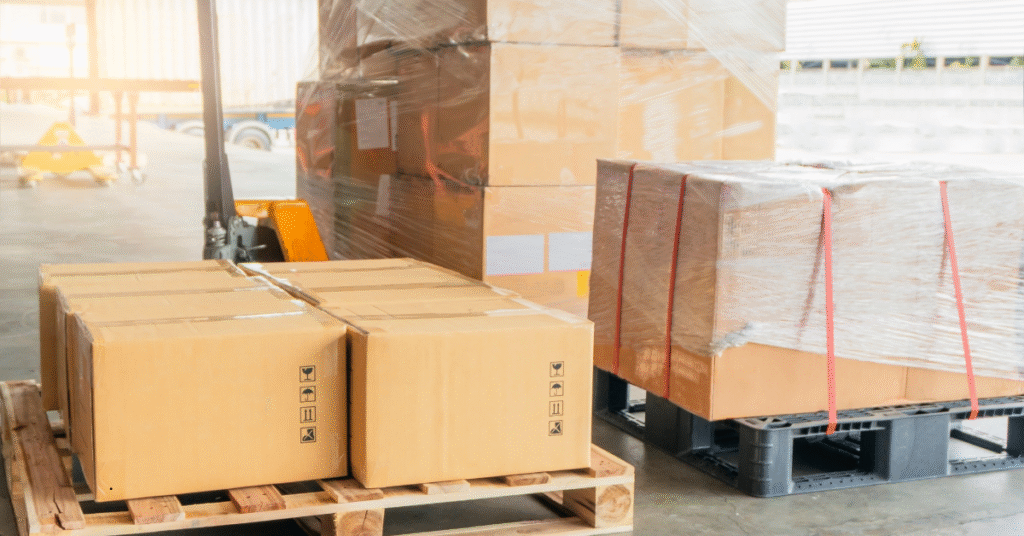Cheapest Way To Ship Packages In 2026

Shipping costs can absolutely wreck your budget if you’re not careful. Whether you’re running a side hustle selling vintage clothes on eBay, sending care packages to friends across the country, or managing a small online store, those shipping fees add up faster than you can say “tracking number.”
I learned this the hard way when I started my first online business. I was so focused on product costs and profit margins that I completely underestimated how much shipping would eat into my earnings. One month, I spent nearly 40% of my revenue just getting packages to customers. Ouch.
But here’s the good news: you don’t have to break the bank to get your packages where they need to go. There are tons of smart, budget-friendly shipping options out there if you know where to look.
And trust me, once you figure out the cheapest way to ship packages, you’ll wonder why you ever paid full price.
What Is The Cheapest Way To Mail A Package?
Straight up, if you’re looking for rock-bottom prices, USPS is usually your best friend. Their Media Mail, Priority Mail, and First-Class Mail services consistently beat out the competition when it comes to affordability.
Now, before you get too excited, you need to understand something important: the weight and size of your package matter. A lot. Shipping a tiny envelope with a birthday card? Super cheap. Shipping a 20-pound box of books? That’s going to cost you more, no matter which carrier you choose.
Think of it like this: shipping costs work kind of like airline baggage fees. The bigger and heavier your stuff, the more you’re going to pay. Simple as that.
Cheapest Way To Ship Packages In 2026
Okay, so you’re probably wondering what your actual options are, right? Let me break down the most affordable shipping methods based on what you’re sending.
The e-commerce world is booming in 2026, which means competition among shipping carriers is fierce. That’s actually great news for us because it means better rates and more options. But it also means you need to do your homework to find the best deal.
Cheapest Way To Ship Small Packages

Small packages are usually the easiest and cheapest to ship. We’re talking envelopes, small boxes, or anything under about 4.5 pounds. Different carriers have their own definitions of “small,” but that’s the general ballpark.
Here’s what you’re looking at price-wise:
- USPS Priority Mail: Gets your package there in 1-3 business days for around $8.25. This is my go-to for most small shipments because it’s fast and affordable.
- UPS Simple Rate: Delivers in 1-5 business days at $9.45. Pretty competitive, especially if you already have a UPS account.
- FedEx One Rate: Takes about 3 business days and costs $10.80. Solid option if you need reliability.
- Sendle Standard: Another 3-day option at $9.40. Great for eco-conscious shippers since they focus on carbon-neutral delivery.
- DHL Express Calculator: This one’s pricier at $50.20 for 1-5 business days. Honestly, I’d skip this for domestic small packages unless you absolutely need DHL’s international network.
IMO, USPS Priority Mail wins for small packages. It’s cheap, reliable, and you can print labels from home. Plus, they give you free boxes and envelopes, which is a nice bonus.
Cheapest Way To Ship Large Packages

Large packages are trickier because the costs can vary wildly based on where you’re sending them. Shipping to Canada from the US? Not too bad. Shipping to Australia? Get ready to open your wallet.
The distance between you and your recipient plays a huge role here. Carriers divide the world into shipping zones, and the farther away the zone, the more you’ll pay.
Here are your best bets for large packages:
- USPS Priority Mail International: Takes 6-10 business days and starts at $28.13. This is usually the cheapest for international shipments.
- UPS Express Saver: Delivers in 1-3 business days for $26 to $72.50, depending on the zone. Faster but pricier.
- FedEx Global One Rate: Ships in 2-5 business days starting at $35.36. Good middle ground between speed and cost.
- DHL Express Worldwide: Gets your package there in under a week for $77.50. Best for when you need guaranteed international delivery.
Pro tip: If you’re shipping something heavy within the US, check out USPS Parcel Select Ground. It’s slower (2-8 days), but it can save you serious money on large, heavy items.
Cheapest Way To Ship The Next Day

Need something delivered yesterday? Overnight shipping is definitely going to cost you more, but some carriers are cheaper than others.
Here’s the deal: overnight shipping only works domestically. If you’re trying to send something to another country overnight, forget it. Even to Canada or Mexico, you’re looking at at least 2-3 days minimum.
Your overnight options:
- USPS Priority Mail Express: Starts at $24.05 for next-day delivery. This is hands-down the cheapest overnight option.
- UPS Next Day Air: Costs $141.70. Yikes. But they do guarantee delivery or your money back.
- FedEx Overnight: Even pricier at $193.20. Only worth it if you absolutely, positively need FedEx’s network.
Real talk: unless you’re in a serious bind, I’d avoid overnight shipping. The price jump from 2-day to overnight is insane. If you can wait just one extra day, you’ll save a ton of money.
Cheapest Way To Ship Packages From Home

One of my favorite money-saving discoveries was learning I could ship packages without ever leaving my house. No more waiting in line at the post office 🙂
USPS makes this super easy. You can print shipping labels online, schedule a free pickup, and just leave your packages on your doorstep. The mail carrier grabs them during their regular route.
As of 2025, here’s what you’re looking at cost-wise:
- Packages under 1 pound: around $2.74
- Packages over 1 pound: around $7
Keep in mind these prices fluctuate based on distance. Shipping across town is cheaper than shipping across the country. Makes sense, right?
FYI, you can also schedule pickups with UPS and FedEx, but they sometimes charge pickup fees. USPS pickup is free, which is another reason I love them for home shipping.
Tips To Saving Money On Shipping Costs
Alright, now let’s talk strategy. Finding cheap carriers is only half the battle. You also need to be smart about how you prepare and ship your packages.
1. Reduce The Weight Of Your Package
This one’s huge. Most carriers charge by the pound, so every ounce you can shave off your package saves you money.
I used to ship products in these heavy cardboard boxes until I realized I was basically paying to ship air and packaging. When I switched to lightweight poly mailers and corrugated boxes, my shipping costs dropped by about 15%.
Here are some tricks:
- Use bubble mailers instead of boxes when possible
- Choose lightweight packing materials (bubble wrap is lighter than newspaper)
- Remove unnecessary packaging from products before shipping
- Use vacuum-sealed bags for clothing and soft items
Even shaving off a few ounces can bump you down to a lower price tier. It’s worth the effort.
2. Use The Right-Sized Packaging
Ever wonder why carriers care so much about box size? It’s because they calculate something called dimensional weight for larger packages.
Basically, if your package is big but light, they’ll charge you based on the space it takes up rather than what it actually weighs. This is how they prevent people from shipping ping pong balls in refrigerator boxes.
My rule: use packaging that’s just slightly bigger than your item. You need a little wiggle room for protection, but not much more than that.
Here’s another money-saver: USPS and DHL offer free packaging materials. Seriously, free. You can order boxes, envelopes, and mailers online, and they’ll ship them to you at no cost. Why would you ever buy packaging when you can get it free?
3. Choose Flat-Rate Shipping When You Can
Flat-rate shipping is one of those things that sounds too good to be true, but it’s legit.
Here’s how it works: you pay one fixed price regardless of weight (up to a certain limit). So if you’re shipping something heavy, flat-rate boxes can save you a fortune.
USPS offers several flat-rate box sizes. The medium flat-rate box, for example, costs around $16 and can hold up to 70 pounds. Try shipping 70 pounds any other way for $16. Not happening.
The catch? Your item has to fit in the specific flat-rate box. If it doesn’t, you’re out of luck. But for things like books, clothing, or small electronics, flat-rate is often the cheapest option.
You can also create your own flat-rate structure if you’re running an online store. Charge customers one price for shipping regardless of what they order. This simplifies your checkout process and can actually increase conversions.
4. Take Advantage Of Shopify Shipping
If you’re selling online through Shopify, you’re missing out big time if you’re not using Shopify Shipping.
Shopify has negotiated discounted rates with major carriers, and they pass those savings on to you. We’re talking up to 80% off regular shipping rates. That’s not a typo.
Plus, everything’s integrated right into your Shopify dashboard. You can compare rates, print labels, and track shipments all in one place. It’s seriously convenient.
Even if you’re not using Shopify, check if your e-commerce platform has similar shipping integrations. Most do, and they can save you both time and money.
5. Know When Rates Change
Here’s something that catches people off guard: shipping rates change every year. Usually around January.
Carriers review their pricing annually and adjust based on fuel costs, labor expenses, and other factors. In recent years, we’ve seen increases of 4-6% pretty much across the board.
Why does this matter? Because if you’re running a business with fixed shipping costs, you need to know when your expenses are about to go up. Otherwise, you might suddenly find yourself losing money on every sale.
Set a calendar reminder to check carrier websites in December. That way, you can adjust your prices or shipping strategies before the new rates hit.
6. Offer Local Delivery Or Pick Up
Want to know the absolute cheapest way to ship packages? Don’t ship them at all.
I know, I know. That sounds like cheating. But hear me out.
If you’re selling locally, offering pickup or local delivery can eliminate shipping costs entirely. During the pandemic, this became super popular, and a lot of businesses have kept it going.
Here’s why it works:
- Zero shipping costs: Obviously, this is the big one.
- Faster delivery: Customers get their items same-day or next-day.
- Builds community: Meeting customers face-to-face creates connections.
- No shipping delays: You control the entire process.
I’ve used local delivery services in my area that charge a flat $5 fee to deliver anywhere in the city. Compare that to $10-15 for shipping, and it’s a no-brainer.
Apps like DoorDash and Roadie now offer package delivery services too. They’re often cheaper than traditional carriers for local deliveries.
Types Of Shipping Options
Let’s talk about the different shipping methods you’ll encounter. Understanding these helps you choose the right option for each situation.
- Flat-Rate Shipping
We covered this earlier, but it’s worth repeating. Flat-rate means you pay the same price regardless of weight, size, or shape (as long as it fits in the designated packaging).
This is perfect for heavy items. I once shipped a 50-pound box of textbooks for $16 using a USPS flat-rate box. Shipping that same box by weight would have cost me over $40.
- Free Shipping
Free shipping isn’t really free, obviously. The seller is either eating the cost or building it into the product price.
From a customer perspective, free shipping is awesome. From a seller perspective, you need to be strategic about it. Offer free shipping only on orders over a certain amount, or factor shipping costs into your pricing.
Studies show that customers are way more likely to complete a purchase when free shipping is offered. It’s a powerful marketing tool, even if it costs you a bit upfront.
- Real-Time Carrier Rate
This is when the exact shipping cost is calculated at checkout based on the package weight, dimensions, and destination.
It’s the most accurate method, but it can lead to sticker shock. Customers add items to their cart, get excited, then see a $25 shipping charge and abandon the purchase.
If you use real-time rates, make sure to display estimated shipping costs early in the shopping process. Surprises at checkout kill conversions.
- Local Shipping
We talked about this already, but local shipping is when you deliver within your city or state. It’s fast, cheap, and builds customer loyalty.
- Overnight Delivery
Next-day delivery, guaranteed. Expensive but sometimes necessary. I only use this for emergencies or when a customer is willing to pay the premium.
- Same-Day Delivery
This is becoming more common in major cities. Companies like Amazon and Instacart have made customers expect same-day delivery for certain products.
For small businesses, offering same-day delivery can be a competitive advantage. Partner with local courier services or use gig economy apps to make it happen.
- International Shipping
Shipping across borders adds complexity and cost. You’ll deal with customs forms, import duties, and longer transit times.
USPS is usually the cheapest for international shipping, but their tracking can be spotty once packages leave the US. For valuable items, I prefer UPS or FedEx despite the higher cost.
- Expedited Shipping
This is faster than standard shipping but not quite overnight. Usually 2-3 day delivery. It’s a good middle ground when customers need something quickly but don’t want to pay overnight prices.
Final Thoughts
Look, I get it. You want to save money on shipping. We all do. But here’s the thing: the absolute cheapest option isn’t always the best option.
I learned this lesson when I tried to save $3 on a shipment by using a super-budget carrier I’d never heard of. The package took three weeks to arrive, the tracking never updated, and my customer was furious. I ended up refunding the entire order and losing both the product and the shipping cost.
So yes, find affordable shipping options. Use the tips in this article. Take advantage of discounts and flat-rate boxes. But also choose carriers you can trust.
USPS, UPS, FedEx, and DHL are popular for a reason. They’re reliable, they have good tracking, and when something goes wrong, they have customer service to help fix it.
My advice? For most situations, stick with USPS. They offer the best combination of low prices and decent service. For valuable items or time-sensitive shipments, spend a little extra on UPS or FedEx.
And remember: shipping is part of your customer experience. A package that arrives late or damaged reflects poorly on you, even if it’s the carrier’s fault. Factor that into your decision-making.
At the end of the day, the cheapest way to ship packages is the method that gets your items to their destination safely, on time, and without breaking your budget. Find that sweet spot, and you’ll be golden.
Happy shipping!








